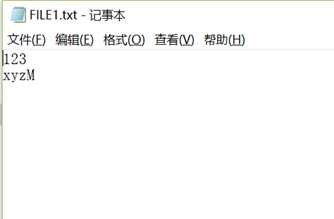标签:标准输出 using 文件 flag 自带 格式 字符串 字符 ima
C++输入输出流包含在头文件<iostream>中,
流的定义如下:
通过设备驱动程序与键盘、屏幕、文件、打印机等进行交互, iostream 类提供与之交互的方法。
输出流:
输出流的对象是字节目标,三个重要的输出流类是ostream、ofstream和ostringsream。
Ostream派生于basic_ostream支持预定义的流对象又:
cout标准输出
cerr标准错误输出,不经过缓冲
clog类似cerr,使用缓冲
注:缓冲是指将所有输出集中存放,然后一次性显示在屏幕上,避免多次刷屏。
格式控制
输出宽度:
输出宽度可以采用<iostream>中自带的width()函数,或者使用< iomanip >中的setw, setw 和宽度均不截断值。
使用width()函数代码如下:
1 #include "stdafx.h"
2 #include <iostream>
3 using namespace std;
4
5 int _tmain(int argc, _TCHAR* argv[])
6 {
7 double values[] = { 1.23, 35.36, 653.7, 4358.24 };
8 for (int i = 0; i < 4; i++)
9 {
10 cout.width(10);
11 cout << values[i] << ‘\n‘;
12 }
13 getchar();
14 return 0;
15 }
使用setw()函数
1 #include "stdafx.h"
2 #include <iostream>
3 #include <iomanip>
4 using namespace std;
5
6 int _tmain(int argc, _TCHAR* argv[])
7 {
8 double values[] = { 1.23, 35.36, 653.7, 4358.24 };
9 for (int i = 0; i < 4; i++)
10 {
11 //cout.width(10);
12 cout << setw(10) << values[i] << ‘\n‘;
13 }
14 getchar();
15 return 0;
16 }
程序运行结果:

宽度设置
设置宽度后,cout默认空白填充,如果需要填充某个字符,可采用fill()或setfill()函数。
采用fill()函数
1 #include "stdafx.h"
2 #include <iostream>
3 using namespace std;
4
5
6 int _tmain(int argc, _TCHAR* argv[])
7 {
8 double values[] = { 1.23, 35.36, 653.7, 4358.24 };
9 for (int i = 0; i < 4; i++)
10 {
11 cout.width(10);
12 cout.fill(‘*‘);
13 cout << values[i] << ‘\n‘;
14 }
15 getchar();
16 return 0;
17 }
采用setfill()函数
1 #include "stdafx.h"
2 #include <iomanip>
3 #include <iostream>
4 using namespace std;
5
6
7 int _tmain(int argc, _TCHAR* argv[])
8 {
9 double values[] = { 1.23, 35.36, 653.7, 4358.24 };
10 for (int i = 0; i < 4; i++)
11 {
12 cout.width(10);
13
14 cout << setfill(‘*‘) << values[i] << ‘\n‘;
15 }
16 getchar();
17 return 0;
18 }
程序运行结果:

精度设置
浮点的默认精度默认为六,如果需要修改,使用setprecision()。数字输出可以设置为固定型和科学型,输出形式采用setiosflags(ios::fixed)控制,fixed表示固定型,scientific表示科学型,默认为科学型。
科学型代码:
1 #include "stdafx.h"
2
3 #include <iostream>
4 using namespace std;
5
6 int _tmain(int argc, _TCHAR* argv[])
7 {
8 double values[] = { 1.23, 35.36, 653.7, 4358.24 };
9 for (int i = 0; i < 4; i++)
10 cout << setprecision(1)
11 << values[i]
12 << endl;
13 getchar();
14 return 0;
15 }
运行结果:

使用固定记数法
1 #include "stdafx.h"
2 #include <iomanip>
3 #include <iostream>
4 using namespace std;
5
6 int _tmain(int argc, _TCHAR* argv[])
7 {
8 double values[] = { 1.23, 35.36, 653.7, 4358.24 };
9 for (int i = 0; i < 4; i++)
10 cout << setiosflags(ios::fixed) << setprecision(1)
11 << values[i]
12 << endl;
13 getchar();
14 return 0;
15 }
运行结果:

将整形数字按照不同进制输出:
1 #include "stdafx.h"
2
3 #include <iostream>
4 using namespace std;
5
6 int _tmain(int argc, _TCHAR* argv[])
7 {
8
9 cout << 3536 << endl;//十进制
10 cout <<dec<< 3536 << endl;//十进制
11 cout << oct << 3536 << endl;//八进制
12 cout << hex << 3536 << endl;//十六进制
13
14 getchar();
15 return 0;
16 }
运行结果:

输入输出数据到文件:
1 #include "stdafx.h"
2 #include <iostream>
3 #include <fstream>
4
5 using namespace std;
6
7
8 int _tmain(int argc, _TCHAR* argv[])
9 {
10 ifstream ifile;
11 char buff[5] = { 0 };
12 ifile.open("d:/FILE1.txt", ios::in);
13 ifile.getline(buff, 5);
14 // Do some output
15 ifile.close(); // FILE1 closed
16
17 cout << buff << endl;//
18
19 getchar();
20 return 0;
21 }
运行结果:

采用>>运算符读入整个字符串:
1 #include "stdafx.h"
2 #include <iostream>
3 #include <fstream>
4
5 using namespace std;
6
7
8 int _tmain(int argc, _TCHAR* argv[])
9 {
10 ifstream ifile;
11 char buff[5] = { 0 };
12 ifile.open("d:/FILE1.txt", ios::in);
13 ifile >> buff;
14 // Do some output
15 ifile.close(); // FILE1 closed
16
17 cout << buff << endl;//
18
19 getchar();
20 return 0;
21 }
运行结果:
写入文件主要采用以下函数:
1 cout.flush() //刷新缓冲区
2 cout.put() //把字符写入流中
3 cout.write() //将字符串写入当前输出流中
代码如下:
1 #include "stdafx.h"
2 #include <iostream>
3 #include <fstream>
4
5 using namespace std;
6
7
8 int _tmain(int argc, _TCHAR* argv[])
9 {
10 ofstream ofile;
11 char buff[5] = { 0 };
12 ofile.open("d:/FILE1.txt", ios::in);
13 if (!ofile)
14 {
15 cout << "打开文件失败" << endl;
16 }
17 ofile << "123" << endl;
18 ofile.write("xyz", 3);
19 ofile.put(‘M‘);
20 ofile.flush();//清空缓冲区
21 ofile.close(); // FILE1 closed
22
23 getchar();
24 return 0;
25 }
运行结果:

标签:标准输出 using 文件 flag 自带 格式 字符串 字符 ima
原文地址:https://www.cnblogs.com/ybqjymy/p/12516107.html